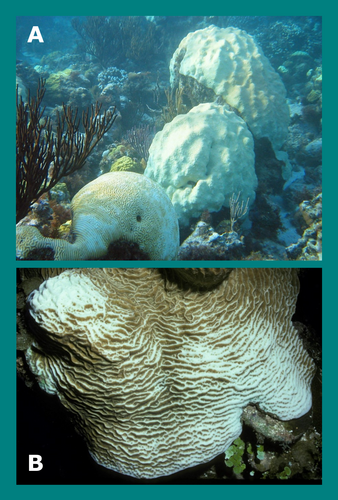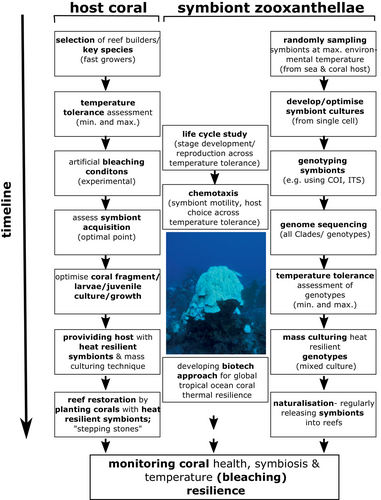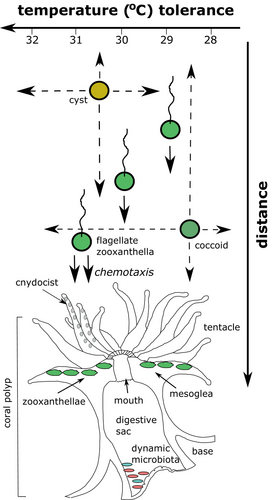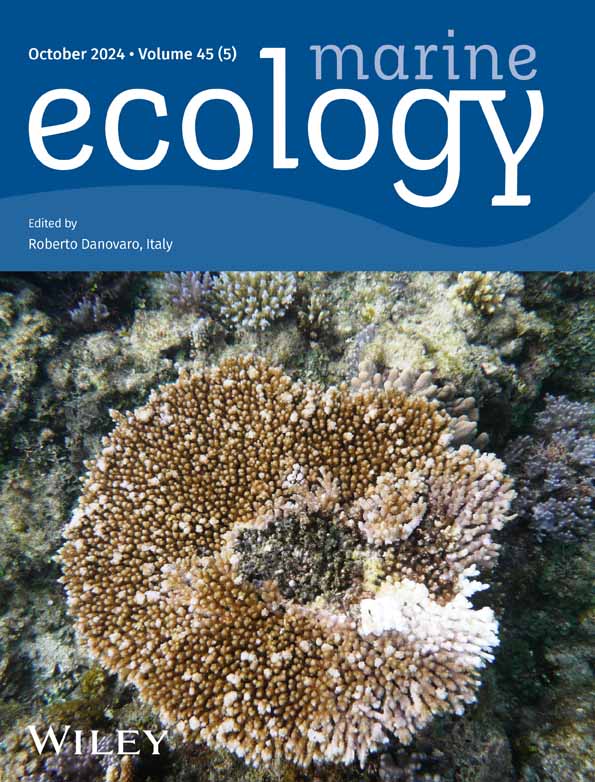Preventing Bleaching in Tropical Corals by Using Thermally Resilient Symbiont Zooxanthellae: All Hands-On Deck!
Funding: The author received no specific funding for this work.
ABSTRACT
The current rapid climate warming is expected to cause an ocean temperature increase of 3°C–5°C by 2100, leading to deoxygenated and acidified tropical seas. Without mitigation measures, the total loss of tropical corals is inevitable. Already, one-third of tropical reefs are considered permanently lost. Coral bleaching initiated by the loss of symbionts, the photosynthetic zooxanthellae, is the main process whereby corals respond to thermal stress, followed by recovery. However, increased thermal stress and frequency of bleaching have caused widespread coral recovery failure. Zooxantheallae of the genus Symbiodinium are considered the thermally vulnerable part of the coral symbiosis. In recent decades, warming has displaced genotypes of lower thermal resilience to subtropical latitudes; few genotypes of higher temperature tolerance remain abundant in tropical seas, but these will not withstand warming predictions either. Interestingly, high temperatures in the Red Sea have selected for exceptionally heat-resistant coral genotypes and for the highest known thermal resilience in endemic zooxanthellae at the same time. Actions to overcome the coral bleaching crisis have been proposed by combining coral ecophysiology and mass culturing of thermally resilient Red Sea symbionts for naturalisation to the global tropical ocean, including restoration of collapsed reefs using corals with thermally resilient symbiont genotypes.
1 Introduction
The survival of tropical coral reefs is at stake. Current rapid climate warming causes ocean temperature increase of 3°C–5°C by 2100 (Collins et al. 2013), causing tropical seas to deoxygenate and acidify. Without mitigation measures, the total loss of tropical corals is inevitable (Hoegh-Guldberg 1999; Wellington et al. 2001; De'ath et al. 2012). Scientists consider one-third of tropical reefs already permanently lost to rapid climate warming, as any current measures aiming at preventing coral loss have failed (De'ath et al. 2012; Kotb et al. 2004; Thatje 2021). Coral bleaching initiated by the loss of symbionts (Figure 1), the photosynthetic zooxanthellae, is the main process whereby corals respond to thermal stress, usually followed by coral recovery. However, increased thermal stress and increased frequency of bleaching have caused widespread coral recovery failure (Hoegh-Guldberg 1999; Kotb et al. 2004; De'ath et al. 2012). Zooxanthellae of the genus Symbiodinium are considered the thermally vulnerable part of the coral symbiosis; several genotypes (often called Clades) of variable thermal resilience are known (Hoegh-Guldberg 1999).

As observed in recent decades, warming has displaced genotypes of lower thermal resilience to the margins of tropical seas and subtropical latitudes, where moderate tropical temperatures prevail (Berkelsman and van Oppen 2006; Sully et al. 2019; Baker et al. 2004). Only two genotypes (Clades C, D) of higher temperature tolerance remain abundant in central tropical waters (Berkelsman and van Oppen 2006; Sully et al. 2019). It has been suggested that these genotypes of highest known thermal tolerance have adapted to 0.5°C of warming over the past decade, and several works proposed that adaptive responses in symbiont thermal tolerances can be seen (Chakravarti, Beltran, and van Oppen 2017; Hughes et al. 2017; Buerger et al. 2020; Chan et al. 2020). However, there is a lack of genomic work to prove that molecular changes of genetic coding improving thermal tolerance have taken place (Buerger et al. 2020). Because both zooxanthellae and their host corals do already thrive at their upper thermal limits (Berkelsman and van Oppen 2006), it is, indeed, more likely that acclimation to slightly elevated sea temperatures, the same as within seasonal acclimations, has resulted in permanently elevated metabolism in these two genotypes (Clades C, D) (Sully et al. 2019).
Acclimation rather than adaptation is supported also by the displacement of any of the other known zooxanthella genotypes to peripheral, subtropical latitudes; even their complete disappearance or extinction is possible (Sully et al. 2019). These observations do support the hypothesis that rapid selection of heat-tolerant zooxanthellae has taken place and that, in the course of continued global warming, these two main heat-tolerant genotypes will not withstand warming predictions either. Consequently, any recent predictions of rapid adaptive evolution (Chakravarti, Beltran, and van Oppen 2017; Hughes et al. 2017; Buerger et al. 2020; Chan et al. 2020) increasing thermal resilience in zooxanthellae do not hold true (Thatje 2021).
Hoegh-Guldberg in his pioneering work published in 1999 predicted that “The fact that corals are so close to their thermal limits is also evidence that they have not been able to acclimatize or adapt to these increases to any real extent.” Hoegh-Guldberg quite rightly predicted a lack of adaptive responses, and the coral symbiosis is therefore entirely reliant upon the species-specific and genetically determined physiological scope, which defines the host–symbiont association's thermal acclimation capability (Pörtner and Farrell 2008).
Interestingly, high temperatures in the Red Sea have selected for exceptionally heat-resistant coral genotypes at its northern end, in the Gulf of Aqaba and for the highest known thermal resilience in endemic zooxanthellae at the same time, predicted to delay bleaching events in the area by at least a century (Fine, Gildor, and Genin 2013; Thatje 2021). Therefore, the Gulf of Aqaba can be considered a thermal refugium from global warming for its corals and associated symbionts (Fine, Gildor, and Genin 2013; Thatje 2021). The area has remained free of bleaching for nearly four decades, even when average summer surface temperatures exceeded by 2°C. In the Gulf of Aqaba, bleaching has been observed at 32.5°C, and in the southern Red Sea only once at extremely high 38°C. Contrarily, the heat wave of 2023 enduring more than 20 weeks, with ocean temperatures 1°C above the average, killed half a million hand-reared coral colonies across seven planted reefs in southern Florida, proving that this decade-old method of reviving reefs alone does not withstand climate warming (Cornwall 2024).
Based on this evidence, the author proposes actions to overcome the global coral bleaching crisis (Glynn 1996; Wellington et al. 2001; Hughes et al. 2017) by combining coral ecophysiology and mass culturing techniques of thermally resilient Red Sea symbionts for naturalisation to the global tropical ocean, including restoration of collapsed reefs by using local corals with thermally resilient symbiont genotypes of Red Sea origin. These actions require a series of fundamental and applied research projects to be conducted at the international level of science cooperation, which are outlined as follows.
2 Investigating the Coral Host
Tropical corals grow at different rates, which scale with temperature, and differences in thermal scope depend on corals' evolutionary history. In order to quickly restore collapsed reefs and/or establish biogeographic stepping-stones to enhance population connectivity among reef fragments, faster growing stony coral species (Loya et al. 2001) should be selected for experimental growth studies (Figure 2). The growing conditions of both fast-growing and slow-growing coral fragments need assessment under controlled laboratory conditions (e.g., Acropora, Pocillopora, Montipora, Orbicella, Montastrea and Favia). The introduction of slow-growing species in this process may serve reef stability and should foster biodiversity in the long term.

There is limited knowledge available of coral thermal tolerance ranges. Mostly, only upper thermal limits have been approached by in situ observations with regard to bleaching events (Thatje 2021; Cornwall 2024). In order to exactly determine physiological thresholds in tropical corals, the upper as well as lower temperature limits for growth and reproduction must be known to, for example, allow the establishment of depth and geographic distribution limits, which are essential when modelling distribution changes within climate warming scenarios. Thermal tolerances should be studied across corals' life cycle, with particular emphasis on reproductive adults and planula larvae; the latter is key in modelling genetic connectivity among, for example, fragmented populations in relation to local hydrography.
It should be highlighted that mesocosm experiments demonstrated that heat-tolerant corals were unable to acclimatize to 1°C higher ocean temperature. The study, however, did not consider any experimental changes in the coral-associated symbiont community (Schoepf et al. 2019). Further, it has been shown that warm temperatures can select corals reproduced from warm-adapted reefs and that this may be an adaptive mechanism in response to climate warming (Drury et al. 2022). However, with symbiosis still being the key to successful temperature tolerance, it has been shown that selective breeding of heat-tolerant corals can improve the thermal tolerance of reefs (Howells et al. 2021; Morikawa and Palumbi 2019). It has also been emphasized that, in order to overcome the bleaching crisis, future approaches of breeding thermally resistant corals through (human)-assisted evolution of heat-tolerant corals may be needed; however, any such approach still needs to be technically accomplished and proven, and therefore remains uncertain (Van Oppen et al. 2015). Overall, differences in thermal tolerances among reefs may be the reason for differences found in reef survival in response to recent El Niño events (Nava et al. 2021).
Bleaching conditions, for example, bleaching temperatures, predominantly obtained from in situ observations (Fabricius et al. 2004; Thatje 2021; Figure 1) are from a physiological point of view little accurate. Consequently, key coral species should be experimentally bleached under controlled laboratory conditions, with temperature and water chemistry being monitored closely. There may be population (location)-specific differences in bleaching temperatures (maximum thermal scope) in species, as previously reported (Thatje 2021; Nava et al. 2021). In order to optimise thermal tolerance in coral cultures for restoration, specimens (e.g., coral fragments or planula larvae) from populations with the highest natural thermal tolerance must be used. Determining the exact thermal conditions under which coral species do bleach–temperature tolerances in invertebrates are known to be species—as well as population-specific (Ravaux et al. 2012; Mardones et al. 2020)—is essential when ascertaining the best point of symbiont (zooxanthella) acquisition. Bleaching (Figure 1) causes the host coral to expel its symbionts, the exact process of which is not yet fully understood and demands further investigation (Donovan et al. 2020). Artificially bleaching corals (e.g., coral fragments in culture) is key to optimising the uptake of heat-resilient symbionts as part of corals' recovery process. Juvenile corals reared from planula larvae do acquire symbionts post-metamorphosis and during settlement and can also be used for mass culturing corals for later naturalisation. These methodologies are key for establishing a heat-resilient host–symbiont association that withstands bleaching temperatures within current climate warming predictions.
3 Investigating the Symbiont Zooxanthellae
Restoration of coral reefs by planting out coral fragments reared in culture is a generally adopted method. In order to avoid coral bleaching (Cornwall 2024), to seek for the highest thermal resilience of symbiosis by providing corals with heat-resistant symbionts is the next logical step. It is argued that the long-term survival of naturalised coral fragments without heat-resistant symbionts is unlikely and within current global warming predictions (Wellington et al. 2001; Collins et al. 2013; Thatje 2021; Cornwall 2024).
The taxonomic status of pelagic dinoflagellate Symbiodinium sp. has been frequently revised. Within Cnidaria, there are several phylogenetic clades as well as subclades known that comprise many morpho-species (LaJeunesse et al. 2018). As for coral symbionts, and within physiological studies, the genomic identity—as defined by select genes (e.g., ITS 1)—is generally used to identify populations (haplotypes) that are also often called clades. These do represent distinct, genomic-based, physiological properties, for example, with regard to temperature tolerance. Further, it has been suggested that the higher genetic diversity of zooxanthellae found in corals correlates with a higher thermal resistance to bleaching, although this alone has not totally prevented corals from bleaching (Cárdenas-Alvarado et al. 2021).
In order to achieve the highest thermal tolerance of the coral host–symbiont association, Symbiodinium need to be obtained from the Red Sea and its northern Gulf of Aqaba during the highest seasonal temperatures (Figure 2). Genotypes of the highest known thermal tolerance (Clades C, D) have never been reported from the area (Fine, Gildor, and Genin 2013), although corals are known not to bleach below high 38°C in the southern Red Sea. This does clearly indicate that the Red Sea must harbour temperature-resilient symbionts unknown to science (Fine, Gildor, and Genin 2013; Thatje 2021).
In order to obtain heat-resilient symbionts for biotechnology approach, isolating randomly selected individual symbionts from either coral mesoglea (Figure 3) or plankton samples must be achieved for optimising single genotype mass cultures in the laboratory, cultivated from single cells (Banaszak and Trench 1995). From these and for each culture (at the scale of > 100 cultures for each geographic region studied), sufficient symbiont biomass for full genotyping must be obtained. Any revealed genotypes must be subjected to full thermal scope growth experiments (Banaszak and Trench 1995, Figure 2). For use in biotechnology approach, genotypes of the highest thermal tolerance should be chosen for establishing high diversity of genotypes in culture, to improve likelihood of coral host compatibility, as well as resilience to environmental stressors, such as salinity and/or pollutants (Donovan et al. 2020). In the course of these thoughts, it should not be forgotten to analyse the possibility of other symbiotic microorganisms (e.g., digestive sac microbiota) to play a role in the thermal resistance of the coral holobiont (Figure 2, see also Maire and van Oppen 2021).

Mass culturing biotechnology approach of symbionts (here: high diversity of genotypes in single culture), as already in use by pharmaceutical companies, applied to any tropical region impacted by bleaching, needs development. Periodic naturalisation of symbionts, first, into coral restoration zones and, second, to the entire tropical ocean, must be envisaged. Further, artificially bleached coral fragments and metamorphosed planula larvae of key coral species should be provided with a high diversity of genotypes from culture for symbiont acquisition, to mass produce heat-resilient corals for reef restoration.
As an additional approach, any Symbiodinium genotypes (Clades, approximately 5–8) from tropical seas as well as any potentially new ones identified from the Red Sea should be subjected to full genome sequencing (Figure 2). The genome of single unicellular algae is relatively concise, and even without knowing the genetic coding and role of each gene, a standardised barcoding comparison of genomes should reveal potential structural differences. These might be of use in future molecular technology approach and by enhancing the physiological (here: thermal) properties of symbionts. Experimentally unravelling gene functioning during heat stress (as from thermal tolerance experiments described earlier) will aid identification of the role, and differences between key genomic sequences, in each symbiont genotype (Avila-Magaña et al. 2021).
4 Mass Culturing Approach for Coral Reef Management and Restoration
Maintaining the various ecosystem services provided by corals, including, for example, coastal protection, and biological carbon sink properties, must be achieved to combat the loss of coral habitat and marine biodiversity, global climate warming and associated ocean acidification (De'ath et al. 2012; Collins et al. 2013; Mollica et al. 2018). In times of warming oceans and predicted expansion of tropical climate zones, healthy and expanding coral reefs will act as an increased biological carbon sink.
The herein outlined research activities developed to prevent tropical corals from bleaching encompass research efforts at the scale of a total of approximately 14 PhD theses (Figure 2).
However, international collaboration, involvement of trained scientists and research management are inevitable to achieve rapid scientific advance. Further, significant knowledge and long-term practice of rearing corals with heat-resilient symbionts for restoration efforts of already collapsed reefs is required. Restoration of reefs should initially be envisaged by establishing local biogeographic, coral stepping-stones in order to reconnect already disconnected reefs and to allow for habitat corridors and population (larval) connectivity, improving the overall tropical ocean biodiversity. Initially, fast-growing and reef-building species should be used to speed up the restoration process. This should be followed by introducing more competitive and slow-growing species in order to stabilise community structure.
Mass culturing of heat-resilient zooxanthellae of Red Sea origin requires the establishment of a small-to-medium-sized international biotechnology company (approximately: 50–100 million dollar annual turnover) that provides these services to countries bordering tropical reefs. Such company would allow for the efficient and local production of large quantities of zooxanthellae for culturing heat-resilient corals hosting these symbionts, as well as the repeated naturalisation of heat-resilient symbionts into the pelagic of coral reef habitats. The successful establishment of the host–symbiont association in reefs—as well as the establishment of Red Sea zooxanthellae within the plankton assemblage—should be regularly monitored by specimen sampling and by applying molecular identification. Further, a thorough ecological risk assessment is required with regard to introducing organisms to new environments. This should include, for example, food web studies to analyse whether the food chain would be altered or anyhow impaired by Red Sea zooxanthellae. Overall, I am convinced that the risks are minimal given the expected and likely low genomic variation among symbionts.
Given the time predicted to get the outlined fundamental research into field application, it is calculated that tropical reefs can be maintained at levels of survival found in 10 to 15 years from now. At that point, at least 50% of tropical reefs will have likely gone lost to global warming. Restoration of already collapsed reefs is possible, at least the development of basic ecosystem functioning (e.g., initially based on low species diversity); however, this approach demands significant science and stakeholder long-term commitment and infrastructure.
Mitigating the effects of global warming will enhance biological carbon capture and long-term carbon fixation supporting the stabilisation of global temperature at predicted mid-century level (approximately 3°C since pre-industrial level). The proposed approach will be by a magnitude cheaper than any of the currently proposed geo-engineering activities to combat global warming, whether including activities on land or in space.
Countries that have already seen significant enhancement of livelihood since early industrialisation should lead the funding of this key global climate warming mitigation programme. The approach provides an opportunity for trading CO2 certificates to compensate for CO2 emissions by industries, supporting coral reef and global climate conservation.
Author Contributions
S.T. conceived the idea and wrote the manuscript.
Acknowledgements
I wish to thank Seán O'Riordan for constructively commenting on the manuscript, as well as William Precht for providing the coral images. Thanks are due to two anonymous reviewers who provided useful thoughts, which helped in further developing this manuscript.
Conflicts of Interest
The author declares no conflicts of interest.
Open Research
Data Availability Statement
All data generated or analysed during this study are included in this published article.




